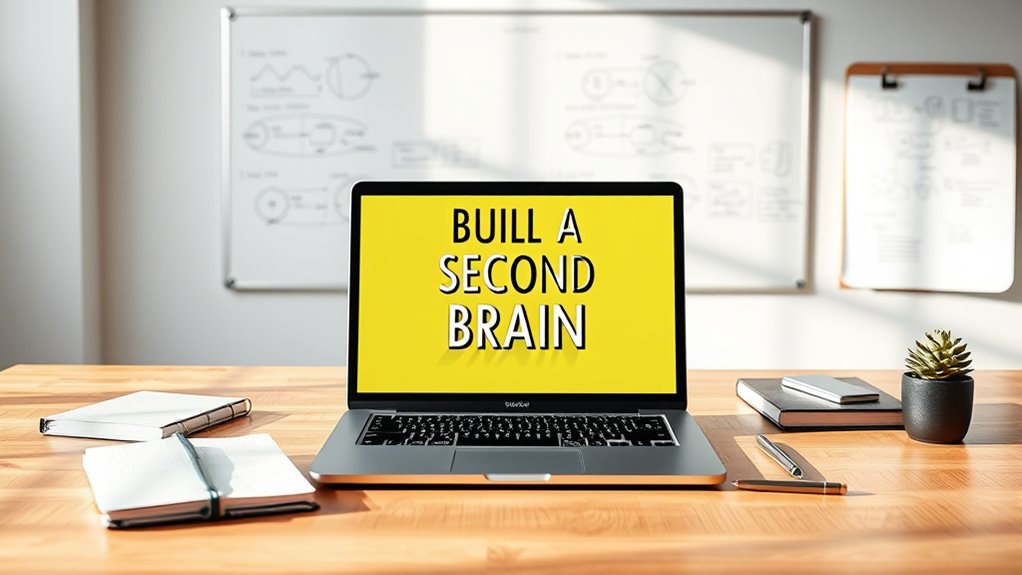Building a second brain means creating an external digital system to organize, store, and find your knowledge easily. You can use digital notes to capture ideas, connect related information, and categorize with tags. Regularly reviewing and updating your notes keeps your system useful and flexible, helping you manage overwhelming information. Over time, this boosts your memory, decision-making, and creativity. Keep exploring to learn how to set up and maintain an effective second brain.
Key Takeaways
- Build an external knowledge system using digital notes to organize, store, and retrieve information efficiently.
- Capture ideas through digital note-taking, then process, categorize, and connect notes for a cohesive knowledge network.
- Establish routines for reviewing and updating notes, using tags and links to enhance organization and accessibility.
- Ensure the system is scalable and flexible to grow with your needs without becoming overwhelming.
- Benefits include improved memory, better decision-making, and unlocking your full potential through effective knowledge management.

In today’s fast-paced world, managing the overwhelming flow of information can feel impossible. Every day, you’re bombarded with emails, articles, ideas, and reminders, making it tough to keep track of what matters most. That’s where building a second brain comes in—an external system that helps you organize, store, and retrieve knowledge efficiently. At the core of this system is digital note taking, which allows you to capture thoughts and information quickly and access them whenever you need. Instead of relying solely on your memory, you create a reliable knowledge management framework that frees your mind from clutter and mental overload.
Digital note taking isn’t just about jotting down ideas; it’s about creating a structured way to process and connect information. When you make notes digitally, you can easily categorize, tag, and search through your data, making it simple to find exactly what you need at any moment. This process turns scattered bits of information into a cohesive network of knowledge. As you accumulate notes, you build a personal database that grows smarter and more useful over time. This isn’t just storage—it’s a dynamic system that supports your learning, creativity, and decision-making. Incorporating knowledge management techniques into your routine ensures your second brain remains organized and effective.
Creating a structured digital system turns scattered ideas into a smart, connected knowledge network.
Using digital note taking as part of your knowledge management strategy means adopting a system that encourages continual organization and refinement. Instead of letting notes pile up chaotically, you develop routines to review and update them regularly. Tagging notes with keywords, linking related ideas, and summarizing key points help you create meaningful connections across different topics. Over time, this approach transforms your digital notes into a powerful knowledge base you can draw from effortlessly. Whether you’re preparing for a project, learning a new skill, or solving a complex problem, your second brain becomes a trusted resource.
The beauty of building a second brain is its scalability. As you gather more information, your system adapts and expands without becoming overwhelming. This flexibility allows you to handle both personal and professional knowledge seamlessly. Instead of trying to memorize everything, you offload the cognitive load onto your digital tools. Your second brain becomes a reliable partner, helping you stay organized, remember important insights, and make better decisions. By mastering digital note taking and integrating it into a comprehensive knowledge management system, you take control of your information flow and unlock your full potential.
Frequently Asked Questions
How Do I Choose the Right Digital Tools for My Second Brain?
To choose the right digital tools for your second brain, start with digital tool evaluation by identifying your specific needs and workflows. Look for apps that integrate well with each other to streamline your process. Prioritize user-friendly interfaces and features that match your habits. Test multiple options, and don’t hesitate to switch if a tool doesn’t fit seamlessly. This way, you build a cohesive, efficient second brain tailored to you.
What Are Common Mistakes to Avoid When Building a Second Brain?
You might stumble by overcomplicating your structure, turning your second brain into a tangled web instead of a streamlined tool. Neglecting regular reviews is like ignoring a garden—it withers and loses its usefulness. To keep it thriving, simplify your system and make review a habit. Avoid these pitfalls, and your second brain will become a reliable extension of your mind, not a confusing maze.
How Can I Ensure My Second Brain Stays Organized Over Time?
To keep your second brain organized over time, you need to focus on habit maintenance and consistent categorization. Make it a routine to review and update your notes regularly, ensuring everything stays relevant and clear. Stick to a system for categorizing new information consistently, so you can find what you need quickly. This ongoing effort helps prevent clutter and keeps your second brain efficient and useful.
Is a Second Brain Suitable for All Types of Professionals?
A second brain suits many professionals because of its versatility and industry applicability, helping you manage information efficiently. Whether you’re in tech, education, or creative fields, it enhances your productivity and organization. You can tailor it to your specific needs, making it a valuable tool regardless of your industry. So, if you’re looking to boost your professional versatility, adopting a second brain can be a smart move for almost any profession.
How Often Should I Review and Update My Second Brain?
Think of your second brain as a garden that needs tending. You should review your review schedule weekly or biweekly to guarantee everything stays fresh and relevant. Update frequency depends on how fast your projects evolve, but aim to refresh key notes monthly or quarterly. Regularly tending your digital garden keeps your second brain vibrant, organized, and ready to support your goals whenever you need it.
Conclusion
By building a second brain, you organize your ideas, streamline your tasks, and access your full potential. You capture insights, connect thoughts, and create clarity. You transform chaos into clarity, confusion into confidence, and overwhelm into order. You harness technology to support your growth, empowerment, and success. Building a second brain isn’t just about storing information; it’s about empowering yourself to think better, work smarter, and live fully. Start today, and watch your possibilities expand.









